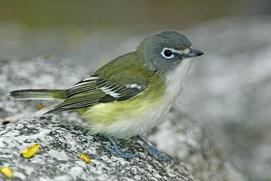BLUE-HEADED VIREO VA-64
Highlands of western Virginia: Mountain Lake
May 23, 8:31 a.m.
Sunrise at 6:08 a.m.
For three minutes and 15 seconds, two males are involved in this territorial confrontation, and we try to follow along:
Perhaps first it's worth just trying to follow the 69 songs of the foreground bird, noting any patterns that we hear. The first ten songs from this bird are typical blue-headed vireo songs, as is the 11th, but the 11th (at 0:28) is a good handle, sufficiently unique that we can be confident we'll recognize it when we hear it again. And there it is again in the 16th position (0:39), and then not again until positions 33, 37, and 40 (1:44 to 2:05). So at first glance it would seem that he sings in packages, delivering several renditions of a given song during a short span, then singing other songs for a while before he returns to the first song.
Listen again and you'll hear other examples like this, such as the song that occurs in positions 18, 20, 23, 26 (0:46 to 1:07) and then again at 43, 45, 47, 50, 54, 57 (2:12 to 2:43).
The foreground bird takes a 24-second break in his singing, during which he offers a few calls and is no doubt listening to his neighbor continue to sing.
As you listen, you inevitably hear that the background and foreground birds are often matching each other with identical songs. The very first foreground song (at 0:03) is matched immediately by the background bird, who sings that song again at 0:14). There are other occasional examples of this matching throughout, perhaps most obvious at 2:33 when the background bird matches the foreground bird.
Background
a Blackburnian warbler, ovenbird.

Photo by John Van de Graaff
